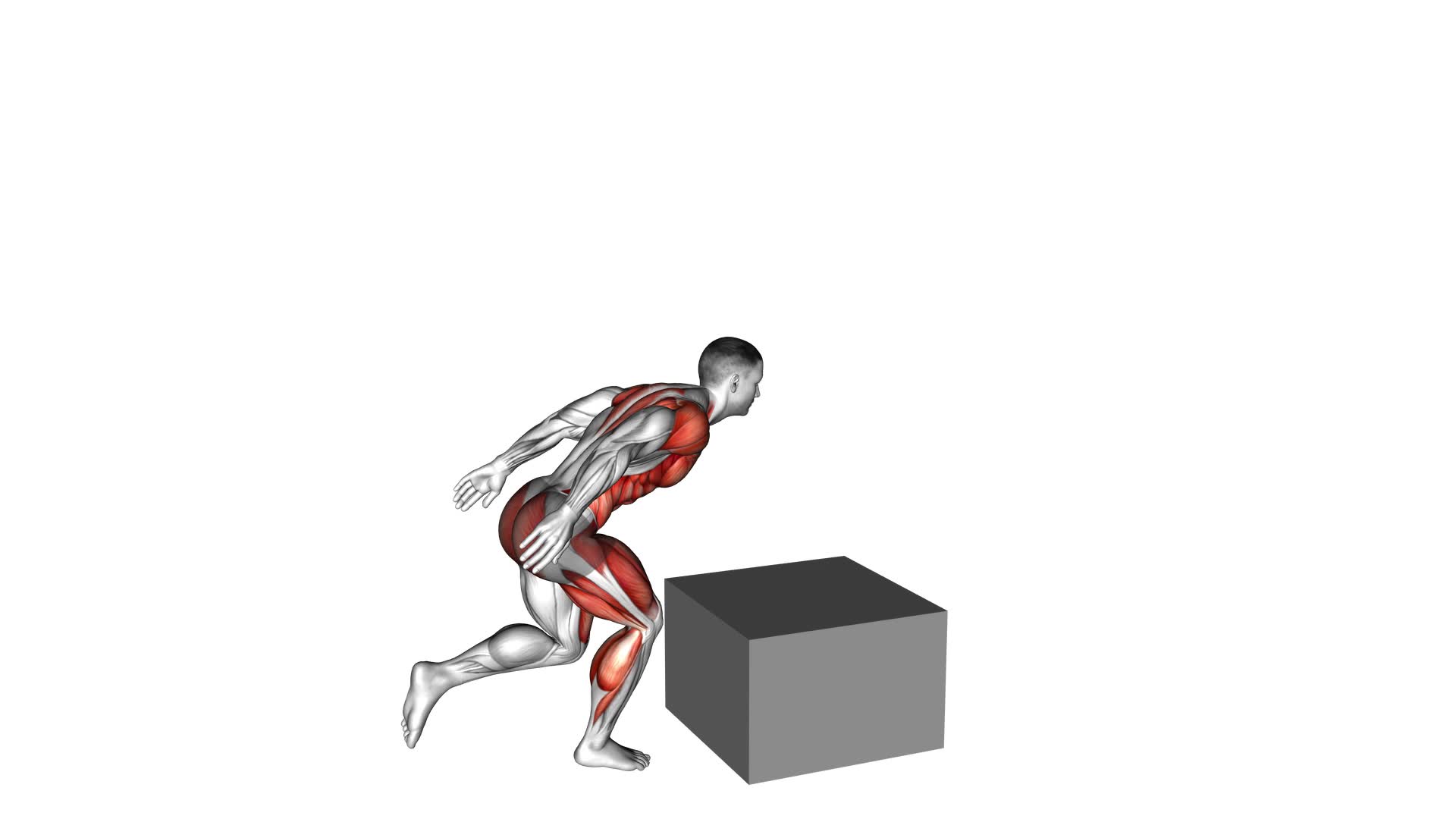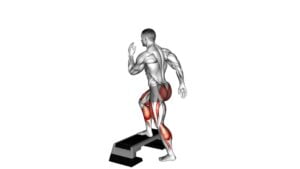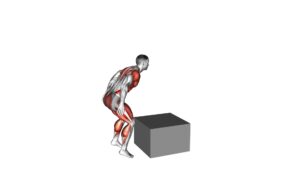Single Leg Box Jump – Video Exercise Guide & Tips

Looking to take your workout to the next level? Check out our Single Leg Box Jump video exercise guide and get ready to boost your lower body strength and explosive power.
Watch This Exercise Video
In this article, we'll walk you through the benefits of Single Leg Box Jumps, the equipment you'll need, proper technique, modifications for different fitness levels, common mistakes to avoid, and tips for maximizing your workout.
Get ready to jump higher, stronger, and more efficiently with this challenging exercise.
Key Takeaways
- Single leg box jumps improve lower body strength and target multiple muscle groups simultaneously.
- They strengthen the glutes, quadriceps, hamstrings, and calves.
- Single leg box jumps work stabilizer muscles for balance and coordination.
- They enhance plyometric abilities for power and explosiveness.
Benefits of Single Leg Box Jumps
To maximize your training results and improve your lower body strength, incorporating single leg box jumps into your workout routine can provide numerous benefits.
Plyometric training, which includes exercises like box jumps, focuses on explosive movements that activate multiple muscle groups simultaneously. By performing single leg box jumps, you engage the muscles in your lower body in a more targeted and challenging way.
One of the key benefits of single leg box jumps is that they help to improve lower body strength. The explosive movement required to jump onto the box activates your glutes, quadriceps, hamstrings, and calves, helping to strengthen and tone these muscles. Additionally, the landing phase of the jump also works your stabilizer muscles, which are crucial for balance and coordination.
Another advantage of incorporating single leg box jumps into your training routine is that they enhance your plyometric abilities. Plyometric exercises are designed to improve your power and explosiveness, which are important for activities that require quick and forceful movements, such as sprinting or jumping. Single leg box jumps train your muscles to generate and absorb force effectively, improving your overall athletic performance.
Equipment Needed for Single Leg Box Jumps
You will need only one piece of equipment for single leg box jumps – a sturdy box or platform. Here are three reasons why having the right equipment is essential for plyometric exercises and lower body strength training:
- Safety: Using a sturdy box or platform ensures stability and reduces the risk of injuries. You can focus on your workout without worrying about the equipment collapsing or shifting.
- Confidence: A reliable box or platform gives you the confidence to push yourself and go for higher jumps. Knowing that the equipment can support your weight allows you to fully engage your muscles and maximize your training.
- Progression: Having a variety of box heights available enables you to progressively increase the difficulty of your jumps. As you get stronger and more proficient, you can challenge yourself by using higher boxes, stimulating continuous improvement.
Proper Technique for Single Leg Box Jumps
To perform single leg box jumps with proper technique, it's crucial to focus on balance and stability. This exercise requires you to engage your core muscles and maintain control throughout the movement.
To prevent injuries, make sure to start with a lower box height and gradually increase as you gain strength and confidence.
Balance and Stability
Achieving optimal balance and stability during single leg box jumps requires a strong foundation and precise body control. To improve stability and enhance your ability to maintain balance, incorporate the following exercises for better balance into your training routine:
- Single-leg stance: Stand on one leg for 30 seconds, gradually increasing the duration as your balance improves.
- Bosu ball exercises: Perform exercises like squats and lunges on a Bosu ball to challenge your stability and engage your core muscles.
- Yoga poses: Incorporate yoga poses such as tree pose and warrior III pose to improve balance, strength, and body awareness.
By consistently practicing these exercises, you'll develop better balance and stability, allowing you to perform single leg box jumps more effectively and reduce the risk of injury.
Now let's move on to the next section where we'll provide injury prevention tips to further enhance your exercise routine.
Injury Prevention Tips
To prevent injuries while performing single leg box jumps, focus on maintaining proper form and technique. Start by warming up your body with dynamic stretches and exercises that target the lower body, such as lunges and squats. These warm-up exercises help to increase blood flow and flexibility, reducing the risk of strains or pulls during the jumps.
When performing the single leg box jump, make sure to land softly with a slight bend in your knee to absorb the impact. Avoid locking your knee or landing with a straight leg, as this can put excessive stress on your joints. Additionally, keep your core engaged and maintain a neutral spine throughout the movement.
By following these injury prevention tips, you can safely perform single leg box jumps and reap their benefits.
Now, let's explore modifications for different fitness levels.
Modifications for Different Fitness Levels
Now let's talk about how to modify the single leg box jump for different fitness levels.
If you're a beginner, there are beginner-friendly modifications you can try to gradually build strength and confidence.
On the other hand, if you're at an advanced level, there are progressions you can incorporate to challenge yourself even further.
Let's explore these modifications and progressions to find the right level for you.
Beginner-Friendly Modifications
Make modifications to the single leg box jump based on your fitness level. If you're a beginner, it's important to start with easier variations to avoid injuries. Here are some beginner modifications and injury prevention techniques to consider:
- Use a lower box height to reduce the impact on your joints and muscles.
- Begin with a two-legged box jump before progressing to a single leg.
- Focus on proper landing technique, ensuring you land softly and absorb the impact with your legs.
By following these modifications and techniques, you can gradually build strength and improve your balance and coordination.
Advanced Level Progressions
If you're ready to challenge yourself further and take your single leg box jumps to the next level, consider incorporating these advanced level variations into your workout routine.
Single leg plyometric exercises can help improve your lower body strength, power, and balance. One advanced level progression is to increase the height of the box. This will require more explosive power and coordination as you jump onto a higher surface.
Another variation is to add weight to your jumps, either by holding dumbbells or wearing a weighted vest. This will further increase the difficulty and intensity of the exercise.
Additionally, you can try performing single leg box jumps with a lateral hop, where you jump sideways onto the box, alternating legs. This challenges your agility and lateral stability.
Incorporating these advanced level progressions will help you continue to push your limits and achieve new levels of fitness.
Common Mistakes to Avoid During Single Leg Box Jumps
To perform single leg box jumps correctly, it's important to avoid the common mistake of leaning forward during the movement. Leaning forward can lead to a loss of balance and increase the risk of injury.
Here are some common mistakes to avoid during single leg box jumps:
- Leaning forward: Leaning forward puts excessive strain on your knees and can cause them to buckle. This increases the risk of knee injuries such as sprains or tears. Keep your torso upright and engage your core muscles to maintain stability.
- Landing with a locked knee: Landing with a locked knee can put stress on your joints and increase the risk of knee injuries. Always aim to land with a slightly bent knee to absorb the impact and protect your joints.
- Not using proper landing technique: Failing to land softly and quietly can indicate poor control and increase the risk of injury. Focus on landing softly with your weight evenly distributed and your knees tracking in line with your toes.
Tips for Maximizing Your Single Leg Box Jump Workout
To maximize your single leg box jump workout, focus on maintaining proper form and increasing the intensity of your jumps. Proper form is crucial for optimizing power and reducing the risk of injury. Start by standing with one foot on the box and the other foot on the ground. Keep your core engaged and chest up as you bend your knee and hinge at the hips, preparing to jump.
As you explode off the ground, drive your arms upward to generate more power. Land softly on the box with your knee bent and absorb the impact through your muscles, not your joints. To increase the intensity, you can add height to the box or perform the exercise at a faster pace.
Plyometric exercises like the single leg box jump are designed to improve explosive power and athleticism, so it's important to challenge yourself and gradually progress. Remember to always listen to your body and consult with a fitness professional if you have any concerns or questions.
Frequently Asked Questions
How Many Calories Can You Burn During a Single Leg Box Jump Workout?
During a single leg box jump workout, you can burn a significant number of calories due to the high exercise intensity. The exact number of calories burned will depend on factors such as your body weight and the intensity of your workout.
However, single leg box jumps are a challenging exercise that engages multiple muscle groups and increases your heart rate, resulting in a higher calorie burn compared to other exercises.
Can Single Leg Box Jumps Help Improve Balance and Stability?
Single leg box jumps are an effective exercise for improving balance and stability. By focusing on one leg at a time, you challenge your core and leg muscles to work together to maintain stability.
This exercise can also help improve your athletic performance by enhancing your power and explosiveness.
Additionally, there are variations of single leg box jumps that can further target specific muscle groups and add variety to your workout routine.
Is It Necessary to Warm up Before Performing Single Leg Box Jumps?
Before performing single leg box jumps, it's essential to warm up. Warming up helps to prepare your muscles and joints for the exercise, reducing the risk of injury. Additionally, warming up increases blood flow and raises your body temperature, enhancing your performance during the workout.
Single leg box jumps can improve your balance and stability by targeting the muscles in your legs and core. So, take a few minutes to warm up before jumping into this exercise for maximum benefits.
How Often Should Single Leg Box Jumps Be Incorporated Into a Workout Routine?
To maximize the benefits of single leg box jumps, it's important to incorporate them into your workout routine regularly. By adding them to your workouts a few times a week, you can improve your lower body strength, balance, and explosive power.
Single leg box jumps are a challenging exercise that target multiple muscle groups, making them a great addition to any workout program. So, aim to include them in your routine for optimal results.
Are There Any Potential Risks or Injuries Associated With Single Leg Box Jumps?
When it comes to single leg box jumps, it's important to be aware of potential risks and common injuries. These exercises can put strain on your joints, especially if you have any existing knee or ankle issues.
It's crucial to ensure proper form and technique to minimize the risk of injury. Start with a lower box height and gradually increase as you build strength and confidence.
Always listen to your body and consult with a professional if you have any concerns.
Conclusion
In conclusion, single leg box jumps are a highly beneficial exercise for improving leg strength, power, and balance. With the proper technique and equipment, individuals of all fitness levels can modify this exercise to meet their needs.
By avoiding common mistakes and following the tips provided, you can maximize the effectiveness of your single leg box jump workout.
Incorporating this exercise into your routine can help you achieve your fitness goals.

Author
Years ago, the spark of my life’s passion ignited in my mind the moment I stepped into the local gym for the first time. The inaugural bead of perspiration, the initial endeavor, the very first surge of endorphins, and a sense of pride that washed over me post-workout marked the beginning of my deep-seated interest in strength sports, fitness, and sports nutrition. This very curiosity blossomed rapidly into a profound fascination, propelling me to earn a Master’s degree in Physical Education from the Academy of Physical Education in Krakow, followed by a Sports Manager diploma from the Jagiellonian University. My journey of growth led me to gain more specialized qualifications, such as being a certified personal trainer with a focus on sports dietetics, a lifeguard, and an instructor for wellness and corrective gymnastics. Theoretical knowledge paired seamlessly with practical experience, reinforcing my belief that the transformation of individuals under my guidance was also a reflection of my personal growth. This belief holds true even today. Each day, I strive to push the boundaries and explore new realms. These realms gently elevate me to greater heights. The unique combination of passion for my field and the continuous quest for growth fuels my drive to break new ground.







